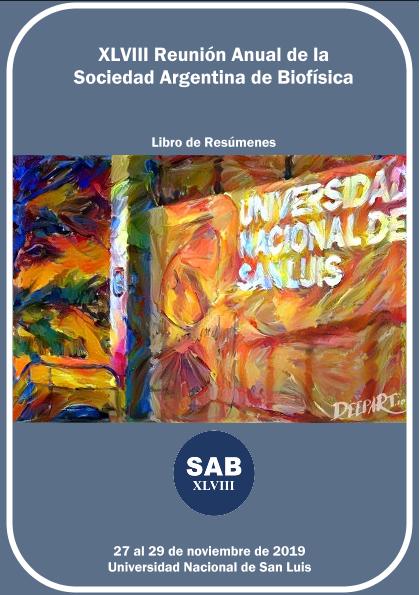Evento
Hidroxynaphthalenecarboxamides and substituted piperazinylpropandiols, two new series of braf inhibitors. A theoretical and experimental study
Campos, Ludmila Estefanía ; Garibotto, Francisco Matías
; Garibotto, Francisco Matías ; Vettorazzi, Marcela Cristina
; Vettorazzi, Marcela Cristina ; Angelina, Emilio Luis
; Angelina, Emilio Luis ; Alvarez, Sergio Eduardo
; Alvarez, Sergio Eduardo ; Enriz, Ricardo Daniel
; Enriz, Ricardo Daniel
 ; Garibotto, Francisco Matías
; Garibotto, Francisco Matías ; Vettorazzi, Marcela Cristina
; Vettorazzi, Marcela Cristina ; Angelina, Emilio Luis
; Angelina, Emilio Luis ; Alvarez, Sergio Eduardo
; Alvarez, Sergio Eduardo ; Enriz, Ricardo Daniel
; Enriz, Ricardo Daniel
Tipo del evento:
Reunión
Nombre del evento:
XLVIII Reunión Anual de la Sociedad Argentina de Biofísica
Fecha del evento:
27/11/2019
Institución Organizadora:
Sociedad Argentina de Biofísica;
Universidad Nacional de San Luis;
Título del Libro:
XLVIII Reunión Anual de la Sociedad Argentina de Biofísica: Libro de resúmenes
Editorial:
Sociedad Argentina de Biofísica
ISBN:
978-987-27591-7-9
Idioma:
Inglés
Clasificación temática:
Resumen
Recently we reported two new structural scaffolds as potential inhibitors of BRAF; both series of compounds were studied in greater depth in the present work. Our results indicate that the new substituted piperazinylpropandiols derivatives evaluated here do not show significantly better activities to that previously reported for the structure chosen as starting structure. In contrast the results obtained for the other series were more positive. We report now new hydroxynaphthalenecarboxamides with significant inhibitory activity on BRAF. In order to better understand these experimental results, wecarried out a molecular modeling study using different combined techniques. While the simulations using simple techniques such as docking and DM simulations allowed us to explain which the best structural scaffold, these results is do not allow to explain why compounds with substituents in different spatial positions have similar inhibitory effects. In this sense, the use of MD/QTAIM combined calculations allow to explain in detail the molecular interactions that stabilize the different molecular complexes reported here. Another interesting contribution of this study is that the different molecular interactions that stabilize the complexes have been analyzed in depth. The QTAIM results indicatethat the different spatial dispositions of the substituents (ortho, meta and para) allow to establish alternative interactions with Asp594 or with Lis483 depending on their spatial arrangement. This result is in agreement to those observed for vemurafenib and dabrafenib. This structural information is important for the design of new inhibitors with this type of structural scaffold.
Palabras clave:
Cancer Melanoma
,
Vemurafenib
,
Molecular Modelling
,
MD/QTAIM
Archivos asociados
Licencia
Identificadores
Colecciones
Eventos(IMIBIO-SL)
Eventos de INST. MULTIDICIPLINARIO DE INV. BIO. DE SAN LUIS
Eventos de INST. MULTIDICIPLINARIO DE INV. BIO. DE SAN LUIS
Eventos(IQUIBA-NEA)
Eventos de INSTITUTO DE QUIMICA BASICA Y APLICADA DEL NORDESTE ARGENTINO
Eventos de INSTITUTO DE QUIMICA BASICA Y APLICADA DEL NORDESTE ARGENTINO
Citación
Hidroxynaphthalenecarboxamides and substituted piperazinylpropandiols, two new series of braf inhibitors. A theoretical and experimental study; XLVIII Reunión Anual de la Sociedad Argentina de Biofísica; San Luis; Argentina; 2019; 162-162
Compartir



